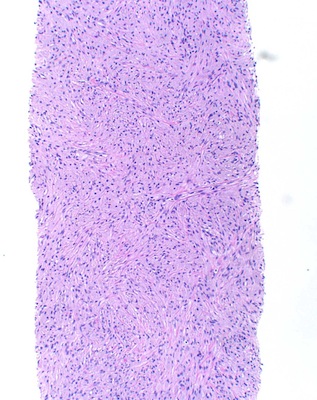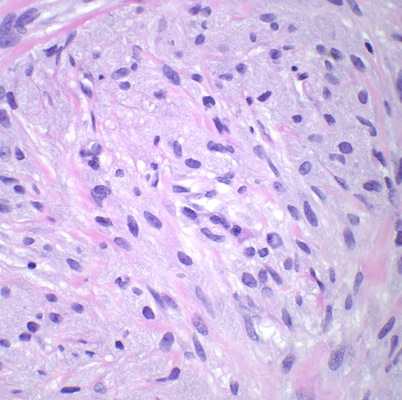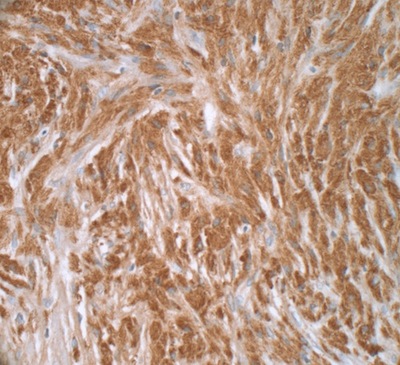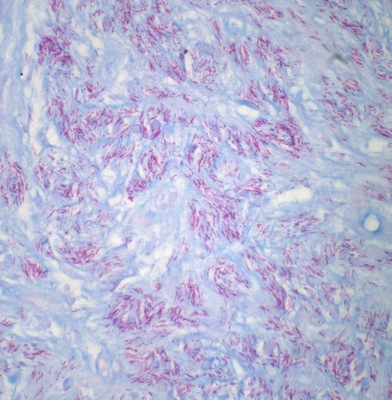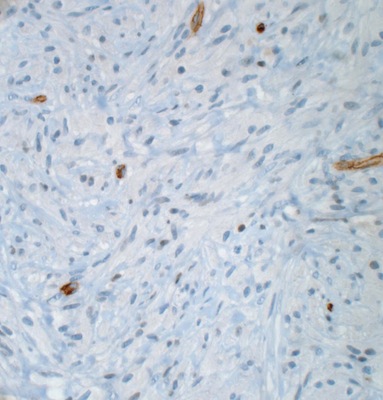28 September 2011 - Case #218
All cases are archived on our website. To view them sorted by case number, diagnosis or category, visit our main Case of the Month page. To subscribe or unsubscribe to Case of the Month or our other email lists, click here.
This case was contributed by Dr. Oluyomi Asojo, University of Cincinnati, Ohio (USA).
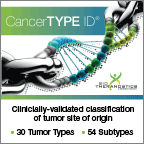
CancerTYPE ID is a standardized, objective molecular test based on the differential expression of 92 genes, that classifies tumors by matching the gene expression pattern of a patients tumor tissue to a database of known tumor types and histological subtypes.
CancerTYPE IDs database includes 2,206 tumors from multiple tumor banks, selected to provide broader and deeper representation of the heterogeneity of tumors. The 92-gene assay does not overlap with IHC markers, providing complementary data to standard tumor diagnosis.
CancerTYPE ID uses real-time reverse transcription polymerase chain reaction (RT-PCR). A very low copy number of RNA molecules can be detected, thus reducing the sample tissue required for testing. Testing is conducted and results are generated at bioTheranostics' CAP-accredited, CLIA-certified laboratory.
Advertisement
Case #218
Clinical history:
A 35 year HIV+ man had diffuse lymphadenopathy (retroperitoneal, paraaortic, supraclavicular, inguinal and mesenteric) and increased FDG uptake on PET CT. His left supraclavicular node was 3.1 cm. A CT guided biopsy of a retroperitoneal lymph node was performed.
Microscopic images:
What is your diagnosis?
Diagnosis: Mycobacterial spindle cell pseudotumor of lymph nodes
Immunostains:
Discussion:
Mycobacterial spindle cell pseudotumor of lymph nodes is a disorder associated with HIV+ patients, often with involvement of many sites. It may also affect infants after bCG vaccination or occur post-transplant (Zhonghua Bing Li Xue Za Zhi 2001;30:89, Am J Clin Pathol 1985;83:524).
Morphologically, the lymph nodes show a partial or complete effacement with a storiform pattern of bland spindle cells, some with vacuoles. There are also numerous vessels lined by plump endothelial cells, plasma cells and lymphocytes. There are no multinucleated tumor cells and no foamy histiocytes. The spindle cells are actually macrophages with large numbers of mycobacteria (Am J Surg Pathol 1992;16:276). Intraoperative touch imprints demonstrate numerous intracellular organisms (Arch Pathol Lab Med 1995;119:811).
The tumor cells are immunoreactive for CD68, S100 and AFB and negative for CD34
The differential diagnosis includes:
Treatment consists of antiretroviral therapy for HIV and antibiotics.
All cases are archived on our website. To view them sorted by case number, diagnosis or category, visit our main Case of the Month page. To subscribe or unsubscribe to Case of the Month or our other email lists, click here.
This case was contributed by Dr. Oluyomi Asojo, University of Cincinnati, Ohio (USA).

CancerTYPE ID is a standardized, objective molecular test based on the differential expression of 92 genes, that classifies tumors by matching the gene expression pattern of a patients tumor tissue to a database of known tumor types and histological subtypes.
CancerTYPE IDs database includes 2,206 tumors from multiple tumor banks, selected to provide broader and deeper representation of the heterogeneity of tumors. The 92-gene assay does not overlap with IHC markers, providing complementary data to standard tumor diagnosis.
CancerTYPE ID uses real-time reverse transcription polymerase chain reaction (RT-PCR). A very low copy number of RNA molecules can be detected, thus reducing the sample tissue required for testing. Testing is conducted and results are generated at bioTheranostics' CAP-accredited, CLIA-certified laboratory.
Website news:
(1) As a result of CAP '11 suggestions, we are working on: (a) finishing the Home Page Topic search by October 31, 2011; (b) more frequent reviews / updates of topics (ongoing); (c) developing a new format for viewing the website on an iPad or Smartphone; (d) possibly developing more social media discussions. Let us know what you think.
(2) Thanks to Dr. Perry Cohen, Montefiore Medical Center of the Albert Einstein College of Medicine, for his suggestion to post Cases of the Week by Category without a diagnosis, which has now been done.
(3) We posted an article on our Management Page, How to Gain a Better Managed Care Contract for your Independent Laboratory, by Mick Raich, Vachette Pathology.
Visit and follow our Blog to see recent updates to the website.
(1) As a result of CAP '11 suggestions, we are working on: (a) finishing the Home Page Topic search by October 31, 2011; (b) more frequent reviews / updates of topics (ongoing); (c) developing a new format for viewing the website on an iPad or Smartphone; (d) possibly developing more social media discussions. Let us know what you think.
(2) Thanks to Dr. Perry Cohen, Montefiore Medical Center of the Albert Einstein College of Medicine, for his suggestion to post Cases of the Week by Category without a diagnosis, which has now been done.
(3) We posted an article on our Management Page, How to Gain a Better Managed Care Contract for your Independent Laboratory, by Mick Raich, Vachette Pathology.
Visit and follow our Blog to see recent updates to the website.
Case #218
Clinical history:
A 35 year HIV+ man had diffuse lymphadenopathy (retroperitoneal, paraaortic, supraclavicular, inguinal and mesenteric) and increased FDG uptake on PET CT. His left supraclavicular node was 3.1 cm. A CT guided biopsy of a retroperitoneal lymph node was performed.
Microscopic images:
What is your diagnosis?
Click here for diagnosis and discussion:
Diagnosis: Mycobacterial spindle cell pseudotumor of lymph nodes
Immunostains:
Discussion:
Mycobacterial spindle cell pseudotumor of lymph nodes is a disorder associated with HIV+ patients, often with involvement of many sites. It may also affect infants after bCG vaccination or occur post-transplant (Zhonghua Bing Li Xue Za Zhi 2001;30:89, Am J Clin Pathol 1985;83:524).
Morphologically, the lymph nodes show a partial or complete effacement with a storiform pattern of bland spindle cells, some with vacuoles. There are also numerous vessels lined by plump endothelial cells, plasma cells and lymphocytes. There are no multinucleated tumor cells and no foamy histiocytes. The spindle cells are actually macrophages with large numbers of mycobacteria (Am J Surg Pathol 1992;16:276). Intraoperative touch imprints demonstrate numerous intracellular organisms (Arch Pathol Lab Med 1995;119:811).
The tumor cells are immunoreactive for CD68, S100 and AFB and negative for CD34
The differential diagnosis includes:
- Kaposi sarcoma: has slit-like spaces and mitotic figures; cytoplasm is not granular or acidophilic; spindle cells are CD31+ and CD34+ but negative for S100, CD68 and AFB (Am J Surg Pathol 1999;23:656)
- Smooth muscle tumor: positive for actin and desmin, negative for S100, CD68 and AFB
Treatment consists of antiretroviral therapy for HIV and antibiotics.

